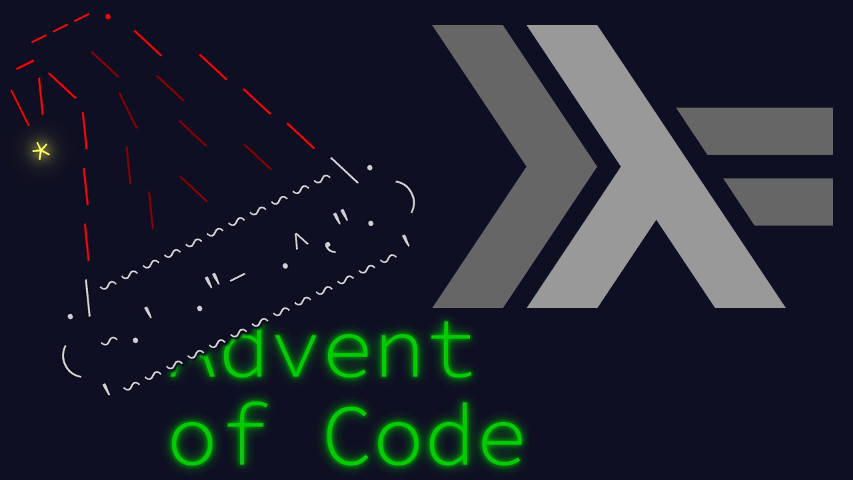For Advent of Code day 2, “Red-Nosed Reports”, we’ll perform various forms of grid analysis. But first a few imports to clear out the literate Haskell situation.
import Control.Arrow ((&&&))
import Data.List (inits,tails)I said grid. So let’s parse a grid. Of Ints.
parse :: String -> [[Int]]
parse = (map . map) read . map words . linesOk, grid. Rows are “reports”; columns are “levels”. The point of the day is to count how many reports are “safe”, a report’s safety being a function of its levels. Let’s quickly define a little helper.
countIf :: (a -> Bool) -> [a] -> Int
countIf = (length .) . filterMmmm, point-free notation. A hard drug, if you ask me. Better saved for the most casual occurrences of programming. Which is the case for AoC.
Anyway, what does it mean for a report to be safe? Paraphrasing the statement, it’s safe if its levels are monotonic, with a sequential pairwise difference exactly between 1 and 3. In point-free style:
isSafe :: [Int] -> Bool
isSafe =
uncurry (||) .
(($ between 1 3) &&& ($ between (-3) (-1))) .
flip all .
(zipWith subtract <*> tail)This may be a bit much at once. Starting with the type signature,
we’re reading a list of Ints, a report of levels, and
outputing a Bool, that level’s safety.
Reading from the end, zipWith subtract <*> tail is
one of those classic abuses of Haskell default typeclass instances. In
this case, a Reader instance on functions. Expanding on
that isn’t really the point of this post1,
just see it as a concise way of duplicating the use of the provided
argument. Or as an S combinator,
if you’re into lambda
calculus. Anyway, as a whole it performs pairwise subtraction.
Then flip all checks all of those deltas pass some
predicate function, yet to be provided.
The last two lines are a common Arrow idiom. The first (lower) line
is an especially common2 abuse, sorry, pattern, of Arrow
notation, where instead of just applying a function to the chain, we
want to apply two, and get a pair in return instead.
Conversely, the second line, uncurry (||), unpacks that
pair to apply the logical or function. So, in effect, those two lines
return the logical or of two functions.
Its a matter of taste as to which of the
uncurry/(&&&) pattern and the
liftA2 one look better. I personally don’t have a strong
preference, and oscillate a lot between the both.
We still need a little helper, that’s not yet provided by the standard library.
between :: Int -> Int -> Int -> Bool
between a b x = a <= x && x <= bA little wrapper, very point-free as well, and we’re done.
main :: IO ()
main = interact $ show . (countIf isSafe &&& countIf isSafe') . parseOh no. I forgot about part 2. Surprise! A new definition for safety. Now a safe report is allowed to drop a single arbitrary level. For redundancy or something. Let’s have a function for that.
leaveOneOut :: [a] -> [[a]]
leaveOneOut = zipWith (++) . inits <*> tail . tailsWe take a list, and return a list of similar lists, dropping all individual elements from it one by one. In point-free syntax again.
You ought to recognize:
- the use of
<*>to use the input argument twice, in this case the list. Precedence might not be obvious.<*>binds looser than(.), so the function really is(zipWith (++) . inits) <*> tail . tails initsandtailsare standard library functions that yield the list of a list’s suffixes and prefixes, respectively. They complement each other quite well, in such a mannerzip inits <*> tailsreturns each input list’s element exactly once per row.- squeezing a
tailnext to thattailsdrops the first suffix, so we’re now matching each prefix with the next suffix. In effect, skipping one element. - instead of simple
zip, wezipWith (++), i.e. concatenate the list portions back together.
And that may have been the most interesting part of the day’s problem. Let’s get back to boring detail and actually implement the new safety check, making good re-use of the version from part 1.
isSafe' :: [Int] -> Bool
isSafe' = any isSafe . ((:) <*> leaveOneOut)Yeah, I couldn’t resist a little more point-free abuse. How does this
work? Mostly, we’re calling leaveOneOut on the input
report, yielding a list of incomplete-by-one reports, and checking if
any of them isSafe.
But that would miss the case where the report is already safe by
part 1 standards. So we include that one as well, by combining
(“consing” (:)) the untouched input report with the
leaveOneOuted ones. S combinator magic again.
That’s it for day 2. You wouldn’t abuse point-free so much in real life, but I have to confess all that AoC does make me appreciate lambda bindings the rest of the year.
See you tomorrow!



